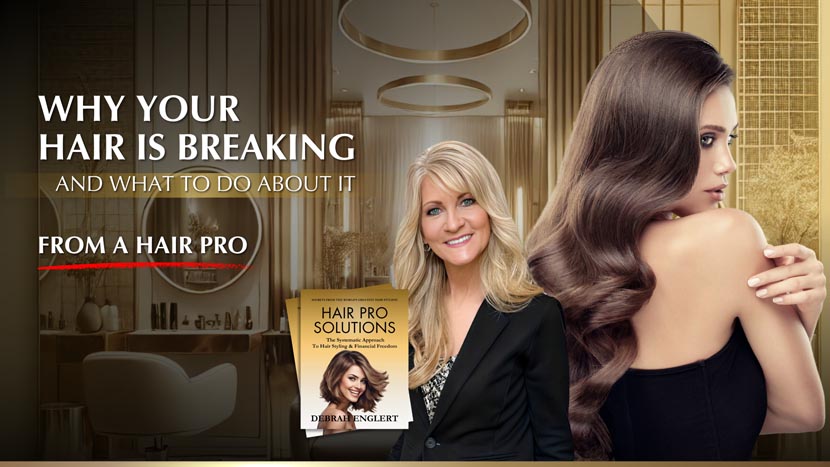WHY YOUR HAIR IS BREAKING AND WHAT TO DO ABOUT IT—FROM A HAIR PRO

If your hair feels like it’s getting shorter instead of longer, if you’re finding tiny broken pieces on your pillow, in your comb, or even your sink, you’re likely dealing with hair breakage, not shedding. The two are often confused, but they’re very different—and require very different solutions.
The good news is that breakage is both preventable and reversible. And as a hair professional, I can tell you: most clients don’t need a full transformation. They just need to understand what’s really going on with their hair.
Let’s take a professional deep dive into what causes breakage, how to identify it, and what to do—step-by-step—to stop it.
WHAT EXACTLY IS HAIR BREAKAGE?
Hair breakage occurs when the strand becomes so weak or brittle that it snaps before reaching its full length. It usually breaks mid-shaft or close to the ends—not from the root. That’s what makes it different from hair loss or normal shedding.
Common signs include:
- Frayed or uneven ends
- Short flyaway hairs near the crown or sides
- Hair that won’t grow past a certain point
- Noticeable thinning, but no visible shedding from the scalp
If that sounds like your current hair situation, don’t panic. You’re not alone—and there’s a clear way forward.
TOP 5 REASONS YOUR HAIR IS BREAKING
1. Heat Damage
Daily use of blow dryers, flat irons, or curling wands without protection weakens your hair’s protein structure. Repeated exposure dries out the hair shaft, making it prone to splitting and snapping.
2. Chemical Overload
Bleach, relaxers, perms, and frequent coloring all alter the hair’s natural bonds. If overused or improperly applied, they compromise your hair’s strength dramatically.
3. Lack of Moisture
Dry hair is fragile hair. Without regular hydration, strands lose elasticity, making them more vulnerable to breakage from brushing, styling, or even sleeping.
4. Mechanical Stress
Tight ponytails, rough towel drying, small elastics, and aggressive detangling all cause physical wear and tear on your strands. The tension adds up fast.
5. Protein Imbalance
Your hair needs both moisture and protein. Too much moisture can make hair stretchy and weak. Too much protein can make it stiff and brittle. Most breakage is a result of this imbalance.
WHAT TO DO ABOUT IT: THE HAIR PRO’S ACTION PLAN
Here’s what I tell my clients when breakage becomes a concern. This plan works when followed consistently—not perfectly, just consistently.
Step 1: Get a Micro-Trim
Start by trimming the worst of the damage. It may feel counterproductive, but trimming off broken, split ends prevents further splitting and helps you retain length in the long run.
Step 2: Hydrate Weekly
Add a deep conditioning treatment to your weekly routine. Look for ingredients like:
- Aloe vera
- Glycerin
- Coconut milk
- Shea butter
- Avocado oil
Focus on mid-length to ends and let it sit for at least 15 minutes. This helps restore flexibility and softness.
Step 3: Reintroduce Protein Gently
Use a protein treatment every 2 to 4 weeks depending on your hair type. Look for hydrolyzed keratin or silk protein in your mask or leave-in. If your hair feels stiff or dry afterward, follow with a moisturizing mask on your next wash day.
Step 4: Minimize Heat and Friction
- Use a heat protectant spray every time you use hot tools
- Lower your heat settings to under 375°F
- Switch to satin or silk pillowcases
- Wrap your hair at night or use protective styles like loose braids or twists
Step 5: Detangle with Care
Always detangle with a wide-tooth comb or fingers. Start from the ends and gently work your way up. Apply a leave-in conditioner or detangler before you start to minimize resistance and tension.
Step 6: Protect Your Hair’s Routine
Avoid overlapping chemical treatments. Space out coloring or relaxing. Stick to a simple, reliable routine of cleanse, condition, treat, and protect. Let your hair recover before introducing new products or services.
WHEN TO SEEK A PROFESSIONAL
If breakage doesn’t slow down after a few weeks of consistent care, consult with a licensed stylist or trichologist. You may be dealing with:
- Scalp imbalances
- Medical conditions (thyroid, anemia, or hormonal shifts)
- Incorrect product use or buildup
- Long-term damage from overlapping treatments
A pro can assess your hair health in real time and tailor a plan to your needs.
Breakage doesn’t mean your hair is hopeless—it means your hair is asking for support. And it’s never too late to listen.
Your hair can grow. It can heal. It can regain strength, softness, and shine. But it takes patience, intentional care, and a commitment to new habits.
Let this be the moment you stop guessing and start knowing how to care for your hair.
And if you ever need support along the way, the pros at Hair Pro Solutions are here to help guide you every step forward.
Have questions about your hair type or damage level?
Email us with questions or book a virtual consultation with a certified Hair Pro Consultant.
